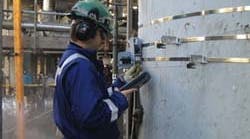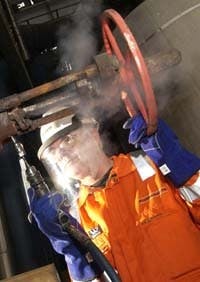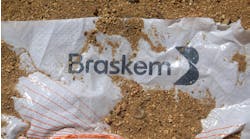Much of the outsourcing now so prevalent in the chemical industry reflects simple economics. Some outsourcing decisions, however, stem more from a lack of internal expertise to tackle the task at hand. Many companies, obviously after considering costs, decide not to build up certain capabilities in-house mainly because they dont have sufficient regular demand for them.
Gamma scanning of distillation columns is a case in point. A widely accepted process diagnostic tool for a couple of decades now, this technique originated back in the 1960s, when the then Imperial Chemical Industries (now ICI), London, U.K., set up its Physics and Radioisotope Services group at its Billingham, U.K., site.
ICI, which has jettisoned many operations related to commodity chemicals over the past decade or so, doesnt have anywhere near as many distillation columns as when it was known as the bellwether of British industry, and no longer has its own in-house scanning capability. That was transformed long ago first into a group service operation and then in 1986 into the international service division, Tracerco, Billingham, U.K., and Pasadena, Texas, offering commercial gamma scanning and other radioisotope tracing and process diagnostic services. ICI divested itself of Tracerco in 2002 when it sold its catalyst operation Synetix (of which Tracerco was the services arm) to Johnson Matthey, London, U.K.
With the notable exception of Eastman Chemicals, which has a scanning team based at its headquarters in Kingsport, Tenn., chemical companies and refiners today rely primarily on a small number of scanning service companies that can bring their expertise to bear on troubleshooting or monitoring the performance of columns.
Tracerco solidified its position as the major player in the field by last year acquiring Quest TruTec from Koch Industries. Other scanning companies include Quantum Technical Services, Houston, Texas; Nuclear Scanning Services (NSS), Houston; Gamma Surveys, Lafayette, La.; TowerScan, Windsor, Ont.; and Scanning Technologies, Edmonton, Alta.
All of these companies use gamma scanning to perform on-line troubleshooting, optimization and predictive maintenance of trayed or packed distillation columns without interfering with the process or tower internals in any way. For instance, the density profiles generated in scans can identify damaged trays and packing, liquid maldistribution, rate-related problems such as weeping or entrainment, and process problems such as fouling or foaming.
The basics
In simple terms, scanning involves positioning a sealed source of gamma radiation on the outside of one side of a column and a suitable radiation detector directly opposite on the other side. Radiation from the source, usually Cobalt 60 or Caesium 137, is focused through a collimator in the sealed source holder toward the column wall. The gamma rays penetrate the wall and are absorbed to differing degrees as they pass through column internals and process liquid and vapor, emerging through the opposite wall to be picked up by the detector. Simultaneously moving the source and detector up or down the column produces a scan of transmitted radiation intensity at different levels, which to the expert eye shows whats actually happening inside the column.
The technology is quite similar, because youre not going to alter the laws of physics on which its based, notes Mark Gledhill, president of TowerScan. Having started with ICI in 1989 and run the Tracerco operation in Canada before setting up TowerScan in 2000, Gledhill has had his expert eye fine-tuned on probably two to three thousand scans over the years.
Chuck Winfield, another ICI alumnus, founded and ran TruTec before starting up Quantum Technical Services three years ago. At Quantum, he says, I have some of the old hands that started with me at TruTec. They have spent over 20 years scanning towers and looking at the graphs. Thats what we bring to the table experience. Its becoming a key for scan companies.
Theres something to be said for having someone on-site with 15 years or more experience, agrees Greg Fox, president of NSS, pointing to the service records of his own staff. Column scanning is different to other services, he explains, because there is an interpretation skill to it. You have to be aware of what affects readings it may be something internal to the process, flooding or foaming for instance, or it may be something mechanical like tray damage.
Winfield makes a similar point: To be an effective scan engineer, you have to combine the scan with your knowledge of distillation and the particular process put that all together and make your call, particularly in cases where the problem might not be something obvious like tray damage or flooding.
Educating process engineers
In most cases, the common practice throughout the scanning community is to make that call following discussion of the scan results with the customers own process engineers. We always tell the customer, says Don Carriere, Scanning Technologies president, we will get the data, but we can only interpret it based on the information you give us. Youre the experts on your process.
However, those process experts within client companies tend not to be around for very long, lament most of the scanning companies. The biggest problem with gamma scanning is education, notes Carriere. We deal with process engineers coming through [the client company], but in three years they could be gone. And if their replacements coming in havent seen a gamma scan, then we have to start all over again. Over at NSS, Fox relates the same experience: Sometimes the engineers we deal with on the plant are fresh out of college, and they might never have heard of scanning. We interpret the results and sit there with the customer and try to understand whats happening. Often its a two-way street, but we dont get people disagreeing with what we say very often.
Recent developments in scanning technologies, however, have made it somewhat easier for the non-expert. Some of these advances, says Gledhill, have been more in the presentation of results, with improved computer graphics and so on, to make them easier to comprehend for someone who isnt looking at scans every day.
Quantum is developing software that will automatically read some scans. This auto-interpretation software will pick out the low-hanging fruit, the easy calls, says Winfield, and shorten the time for training new engineers. We have a couple of beta versions that may be rolled out in a couple of months.
Permanent fix
Tracerco meanwhile has been developing an alternative to conventional tower scanning. In contrast to the usual approach of setting up the source and detector systems each time a scan is required, its Diagnostics RapidScan system is permanently installed on a column to provide process engineers with the option of online repeat scans or scanning multiple times at different rates to evaluate mechanical-, rate- or process-related problems. The approach affords all the capabilities of conventional tower scanning and may improve the ability to diagnose more subtle process changes by stringently controlling and eliminating variability in scan-line orientations and paths, the company claims.
Combining a wireless detection system with an easy-to-install permanent scanning guidewire system, the RapidScan technology eliminates the costs of building scaffolding or renting cranes for columns with limited or no ladder or platform access. All scanning operations are performed from ground level with no need to climb the tower (Figure 1).
Figure 1. The RapidScan system allows engineers to run scans from the ground level, eliminating the need to climb towers.
The stainless-steel pulleys and brackets required for the source and detector are affixed to the existing structure using insulation bands; no welding or direct attachment to the column walls is necessary.
Having the scanning infrastructure permanently in place offers an additional benefit reduced time to conduct a scan, which in turn lessens the burden on plant operators to hold the column at set conditions while scanning, says Tracerco.
The future
While a development like RapidScan will enable columns to be scanned much more easily and frequently than before, it will not necessarily overcome operating companies traditional resistance to having dedicated specialists on-site. However, several scanning-service providers are promoting the benefits of establishing permanent teams. Ive tried to argue with some plants that they would be better off with someone there permanently, says Fox. That way you can eliminate the unknowns, do away with the guessing that goes on before a company decides to call for a scan.
Winfield also thinks dedicated on-site scanning crews could be the wave of the future. Service companies can come up with some pretty innovative ways of pricing, he says. Ive approached several companies with large complexes that could justify a dedicated team between them. They could be integrated with the plant, attending morning meetings and so on. You could price that on, say, a base fee plus whatever savings we generate.
Figure 2. Multi-year contract provides permanent on-site team to handle a variety of maintenance jobs such as pressurized leak sealing.
This approach has certainly proven extremely successful for a service company and its clients in a different, though equally important, area of plant operation. Perhaps better known for its leak-sealing service (Figure 2), Furmanite, LaPorte, Texas, and Kendal, U.K., provides online valve testing and repair, in-situ machining, controlled bolting and pressure systems integrity management, composite repair and hot tapping pipeline interventions. Normally, operating companies call in its teams to tackle problems on a reactive basis often to tide a plant over until scheduled shutdowns.
Last year, however, Furmanite signed a five-year contract with Shell to provide a permanent on-site core team at the oil giants Stanlow, U.K., complex, one of Europes largest refineries. Shell not only gains unrestricted access to our services and a rapid response engineering resource but also a proactive team able to monitor and recommend, as well as undertake repair and maintenance work as required, says business development manager Mike Tucker.
To counter Shells initial reluctance, Furmanite proposed very keen KPIs [key performance indicators] to monitor the non-productive time of the on-site team, Tucker explains, so theyre not going to be sitting around waiting for things to go wrong. Its a transparent process. By being on-site and having an intimate knowledge of the real issues, we can tailor the solution to suit the requirements; nothing more, nothing less.
So successful has this outside in, outsourcing approach been for both companies Tucker says in some cases Shell has experienced an 80% cost saving by treating the patient when its only sneezing that Furmanite now has similar contracts on other refineries and petrochemical complexes run by the likes of BP, Ineos, Innovene and ConocoPhillips, as well as for British Energys nuclear power stations.
Echoing Fox, Tucker says: It takes away the unknown factor, and its the unknown factor that ends up costing money. And, as customers of scanning companies know only too well, investing a few thousand dollars in their services can save millions in avoiding unplanned shutdowns.




